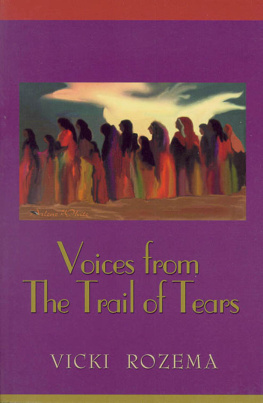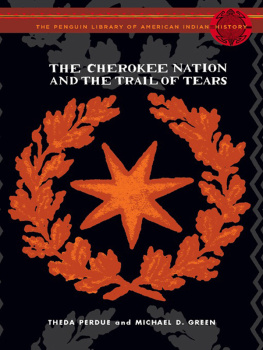Vicki Rozema - Footsteps of the Cherokees: A Guide to the Eastern Homelands of the Cherokee Nation
Here you can read online Vicki Rozema - Footsteps of the Cherokees: A Guide to the Eastern Homelands of the Cherokee Nation full text of the book (entire story) in english for free. Download pdf and epub, get meaning, cover and reviews about this ebook. year: 2013, publisher: Blair, genre: Politics. Description of the work, (preface) as well as reviews are available. Best literature library LitArk.com created for fans of good reading and offers a wide selection of genres:
Romance novel
Science fiction
Adventure
Detective
Science
History
Home and family
Prose
Art
Politics
Computer
Non-fiction
Religion
Business
Children
Humor
Choose a favorite category and find really read worthwhile books. Enjoy immersion in the world of imagination, feel the emotions of the characters or learn something new for yourself, make an fascinating discovery.
- Book:Footsteps of the Cherokees: A Guide to the Eastern Homelands of the Cherokee Nation
- Author:
- Publisher:Blair
- Genre:
- Year:2013
- Rating:3 / 5
- Favourites:Add to favourites
- Your mark:
Footsteps of the Cherokees: A Guide to the Eastern Homelands of the Cherokee Nation: summary, description and annotation
We offer to read an annotation, description, summary or preface (depends on what the author of the book "Footsteps of the Cherokees: A Guide to the Eastern Homelands of the Cherokee Nation" wrote himself). If you haven't found the necessary information about the book — write in the comments, we will try to find it.
The presence of the once-powerful Cherokees is still evident throughout the southeastern United States in names like Chickamauga, Hiwassee, Chattahoochee, Unicoi, Oconee, and Tuscaloosa. For those interested in learning more about the rich heritage of the Cherokees by visiting their historic sites, the second edition of Vicki Rozemas Footsteps of the Cherokees: A Guide to the Eastern Homelands of the Cherokee Nation is an excellent guide.
In the early 1800s, the Cherokee Nation reached from western North Carolina to middle Tennessee, and south to northern Alabama, Georgia, and South Carolina. Then, in 1838, thousands of Cherokees were forced to leave their farmlands, homes, and sacred sites during that infamous trek to Oklahoma, the Trail of Tears. Rozema traveled over 4,000 miles and spent four years and close to 2,500 hours visiting, researching, and photographing the sites of the Cherokee Nation. Footsteps of the Cherokees is a guide to these scenic, cultural, and historic locations. The book is divided into two sections. In the overview, Rozema traces the history of the Cherokees from their prehistoric ancestors to their interaction and conflict with white explorers and settlers to stories of the few who remained behind after the forced march west. This information puts the 190 sites listed in the book into historical perspective. The second section focuses on the sites themselves. The sites are divided into nineteen areas named after central locations. The starting locations include Chattanooga, Knoxville and Maryville, Atlanta, the Blue Ridge Parkway, Great Smoky Mountains National Park, Northeast Georgia, Northwest Alabama, and South Carolina. The coverage of each site includes a discussion of the areas history, background information, detailed directions, hours of operation, entrance fees, and important phone numbers. The book includes over 200 black-and-white photographs.
Take an afternoon or weekend and travel back in time to the glory days of the Cherokee Nation. Whether in your car or favorite armchair, Footsteps of the Cherokees will take you to the great tribes hunting grounds, battlegrounds, sacred lands, homelands, birthplaces, and burial sites.
Vicki Rozema is the author of Cherokee Voices: Early Accounts of Cherokee Life in the East and Voices from the Trail of Tears and Voices from the Trail of Tears. The first edition of Footsteps of the Cherokees received an Award of Merit from the Tennessee Historical Commission in 1996. Also an acclaimed photographer, she is a history professor at the University of Tennessee.
Vicki Rozema: author's other books
Who wrote Footsteps of the Cherokees: A Guide to the Eastern Homelands of the Cherokee Nation? Find out the surname, the name of the author of the book and a list of all author's works by series.









